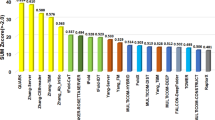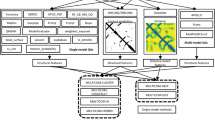Abstract
Prediction of the three-dimensional (3D) structure of a protein from its sequence is important for studying its biological function. With the advancement in deep learning contact distance prediction and residue–residue coevolutionary analysis, significant progress has been made in both template-based and template-free protein structure prediction in the last several years. Here, we provide a practical guide for our latest MULTICOM protein structure prediction system built on top of the latest advances, which was rigorously tested in the 2018 CASP13 experiment. Its specific functionalities include: (1) prediction of 1D structural features (secondary structure, solvent accessibility, disordered regions) and 2D interresidue contacts; (2) domain boundary prediction; (3) template-based (or homology) 3D structure modeling; (4) contact distance-driven ab initio 3D structure modeling; and (5) large-scale protein quality assessment enhanced by deep learning and predicted contacts. The MULTICOM web server (http://sysbio.rnet.missouri.edu/multicom_cluster/) presents all the 1D, 2D, and 3D prediction results and quality assessment to users via user-friendly web interfaces and e-mails. The source code of the MULTICOM package is also available at https://github.com/multicom-toolbox/multicom.
Access this chapter
Tax calculation will be finalised at checkout
Purchases are for personal use only
Similar content being viewed by others
References
The UniProt Consortium (2018) UniProt: the universal protein knowledgebase. Nucleic Acids Res 46(5):2699
Berman HM, Westbrook J, Feng Z, Gilliland G, Bhat TN, Weissig H, Shindyalov IN, Bourne PE (2000) The protein data bank. Nucleic Acids Res 28(1):235–242
Wang Z, Eickholt J, Cheng J (2010) MULTICOM: a multi-level combination approach to protein structure prediction and its assessments in CASP8. Bioinformatics 26(7):882–888
Hou J, Wu T, Cao R, Cheng J (2019) Protein tertiary structure modeling driven by deep learning and contact distance prediction in CASP13. Proteins 87(12):1165–1178
Eswar N, Webb B, Marti-Renom MA, Madhusudhan M, Eramian D, Shen MY, Pieper U, Sali A (2006) Comparative protein structure modeling using Modeller. Curr Protoc Bioinformatics 15(1):5.6.1–5.6.30
Rohl CA, Strauss CE, Misura KM, Baker D (2004) Protein structure prediction using Rosetta, Methods in enzymology, vol 383. Elsevier, Amsterdam, pp 66–93
Morcos F, Pagnani A, Lunt B, Bertolino A, Marks DS, Sander C, Zecchina R, Onuchic JN, Hwa T, Weigt M (2011) Direct-coupling analysis of residue coevolution captures native contacts across many protein families. Proc Natl Acad Sci U S A 108(49):E1293–E1301
Adhikari B, Hou J, Cheng J (2017) DNCON2: Improved protein contact prediction using two-level deep convolutional neural networks. Bioinformatics 34(9):1466–1472
Wang S, Sun S, Li Z, Zhang R, Xu J (2017) Accurate de novo prediction of protein contact map by ultra-deep learning model. PLoS Comput Biol 13(1):e1005324
Adhikari B, Cheng J (2018) CONFOLD2: improved contact-driven ab initio protein structure modeling. BMC Bioinformatics 19(1):22
Abriata LA, Tamò GE, Monastyrskyy B, Kryshtafovych A, Dal Peraro M (2018) Assessment of hard target modeling in CASP12 reveals an emerging role of alignment-based contact prediction methods. Proteins 86:97–112
Cao R, Bhattacharya D, Adhikari B, Li J, Cheng J (2016) Massive integration of diverse protein quality assessment methods to improve template based modeling in CASP11. Proteins 84:247–259
Cao R, Bhattacharya D, Adhikari B, Li J, Cheng J (2015) Large-scale model quality assessment for improving protein tertiary structure prediction. Bioinformatics 31(12):i116–i123
Li J, Deng X, Eickholt J, Cheng J (2013) Designing and benchmarking the MULTICOM protein structure prediction system. BMC Struct Biol 13(1):2
Remmert M, Biegert A, Hauser A, Söding J (2012) HHblits: lightning-fast iterative protein sequence searching by HMM-HMM alignment. Nat Methods 9(2):173
Magnan CN, Baldi PJB (2014) SSpro/ACCpro 5: almost perfect prediction of protein secondary structure and relative solvent accessibility using profiles, machine learning and structural similarity. Bioinformatics 30(18):2592–2597
Deng X, Eickholt J, Cheng J (2009) PreDisorder: ab initio sequence-based prediction of protein disordered regions. BMC Bioinformatics 10(1):436
Bhattacharya D, Cao R, Cheng J (2016) UniCon3D: de novo protein structure prediction using united-residue conformational search via stepwise, probabilistic sampling. Bioinformatics 32(18):2791–2799
Bhattacharya D, Cheng J (2015) De novo protein conformational sampling using a probabilistic graphical model. Sci Rep 5:16332
Cheng J (2008) A multi-template combination algorithm for protein comparative modeling. BMC Struct Biol 8(1):18
Zhang Y (2008) I-TASSER server for protein 3D structure prediction. BMC Bioinformatics 9(1):40
Pettersen EF, Goddard TD, Huang CC, Couch GS, Greenblatt DM, Meng EC, Ferrin TE (2004) UCSF Chimera—a visualization system for exploratory research and analysis. J Comput Chem 25(13):1605–1612
Schrodinger L (2010) The PyMOL molecular graphics system. Version 1.3r1
Sayle R (1992) RasMol v2.5
Adhikari B, Nowotny J, Bhattacharya D, Hou J, Cheng J (2016) ConEVA: a toolbox for comprehensive assessment of protein contacts. BMC Bioinformatics 17(1):517
Söding JJB (2004) Protein homology detection by HMM–HMM comparison. Bioinformatics 21(7):951–960
Zhang Y, Skolnick J (2004) Scoring function for automated assessment of protein structure template quality. Proteins 57(4):702–710
Acknowledgments
The work was supported by an NIH grant (R01GM093123) and NSF grants (IIS1763246 and DBI1759934) to J.C.
Author information
Authors and Affiliations
Corresponding author
Editor information
Editors and Affiliations
Rights and permissions
Copyright information
© 2020 Springer Science+Business Media, LLC, part of Springer Nature
About this protocol
Cite this protocol
Hou, J., Wu, T., Guo, Z., Quadir, F., Cheng, J. (2020). The MULTICOM Protein Structure Prediction Server Empowered by Deep Learning and Contact Distance Prediction. In: Kihara, D. (eds) Protein Structure Prediction. Methods in Molecular Biology, vol 2165. Humana, New York, NY. https://doi.org/10.1007/978-1-0716-0708-4_2
Download citation
DOI: https://doi.org/10.1007/978-1-0716-0708-4_2
Published:
Publisher Name: Humana, New York, NY
Print ISBN: 978-1-0716-0707-7
Online ISBN: 978-1-0716-0708-4
eBook Packages: Springer Protocols




